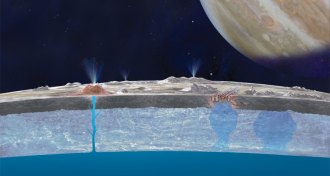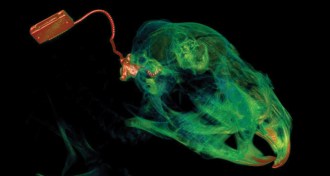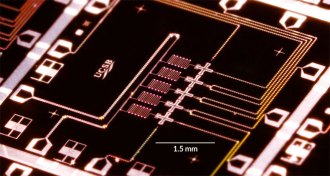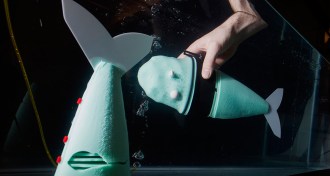Tech
Sign up for our newsletter
We summarize the week's scientific breakthroughs every Thursday.
-
 Planetary Science
Planetary ScienceThe ice of a distant moon
Jupiter’s moon Europa hides a liquid ocean, and conceivably life, under kilometers of ice. The challenge for engineers is how to penetrate that frozen barrier with technology that can be launched into space and operated remotely.
By Meghan Rosen -
 Chemistry
ChemistryElement 117 earns spot on periodic table
Atoms jam-packed with 117 protons have been produced at a particle collider in Germany, confirming the discovery of a new element.
-
 Chemistry
ChemistryColor-changing polymer maps fingerprints
Tiny beads of sweat may offer new way to identify people’s fingerprints.
By Meghan Rosen -
 Genetics
GeneticsGene therapy with electrical pulses spurs nerve growth
Deaf guinea pigs' hearing improves with electrical pulses from a hearing implant are combined with gene therapy, a new study shows.
-
 Quantum Physics
Quantum PhysicsMajor step taken toward error-free computing
Physicists have achieved nearly perfect control over a bit of quantum information, bringing them a step closer to error-free computation.
-
 Tech
Tech‘You Are Here’ maps course for directionally challenged
A Boston Globe technology reporter chronicles the evolution of navigational and mapmaking tools in "You Are Here."
-
 Tech
TechAnimated movies made by computer
A 17-minute animated movie made with a computer in 1964 took 2,000 hours of film processing and cost $600 per minute. The 2013 animated film Frozen cost about $1.5 million per minute to make.
-
 Tech
TechTo do: Exhibits to explore this May in D.C. and New York
Events include a celebration of science and original watercolor paintings from John James Audubon.
-
 Computing
ComputingApp could cut jet lag short
A new app calculates lighting schedules to help travelers adjust quickly to new time zones.
By Meghan Rosen -
 Tech
TechAtlantic razor clam inspires robot to dig deeper
A robot digs using the same method as the Atlantic razor clam.
-
 Tech
TechSoft robots go swimming
A new robotic fish can wiggle and writhe like the real thing.
By Meghan Rosen -
 Quantum Physics
Quantum PhysicsU.S. marches to tick of new clock
The atomic clock NIST-F2 has launched as the country’s official civilian time and frequency standard.